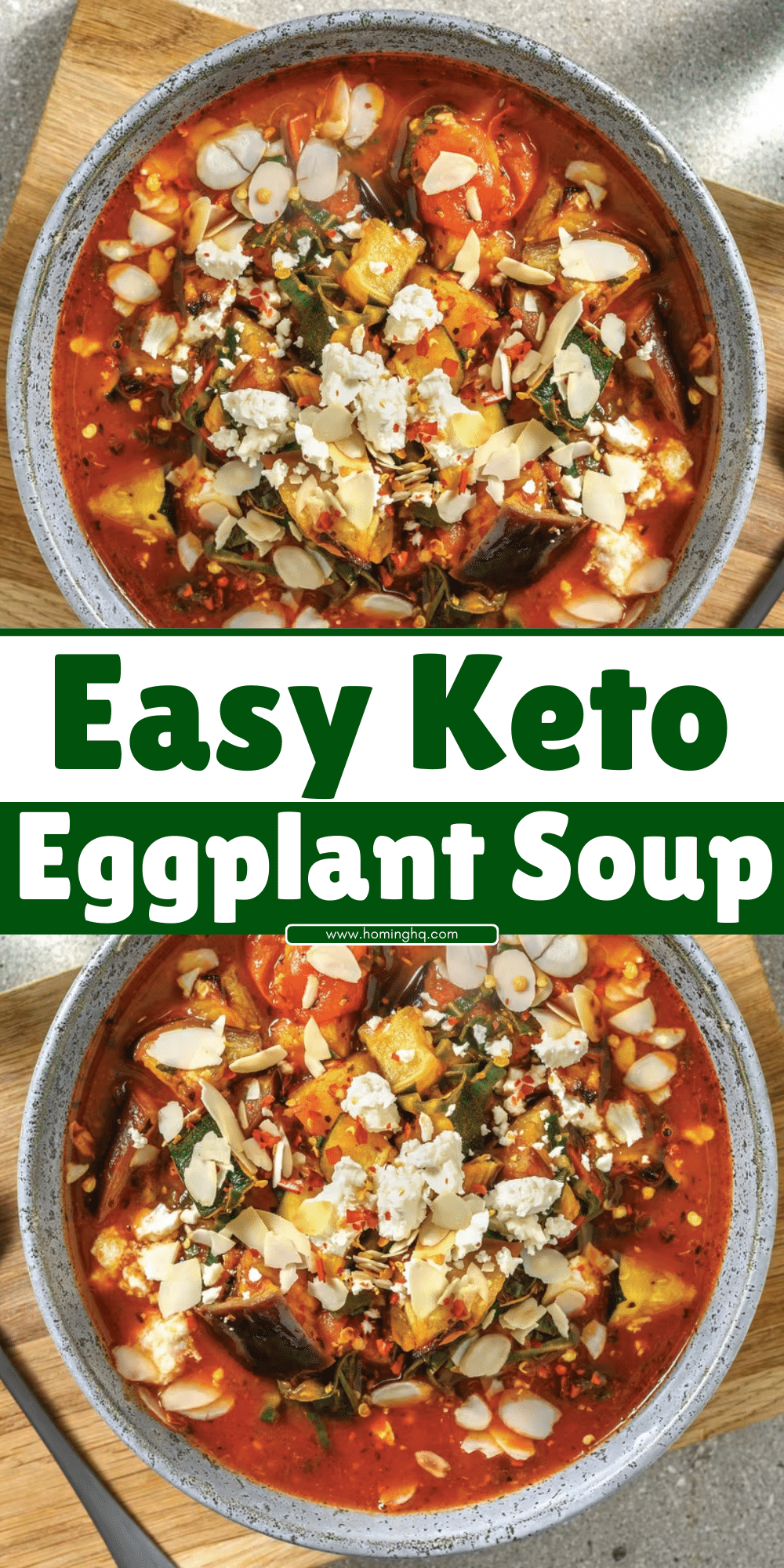All products are selected by our editorial team for quality. If you buy through our links, we may earn a small commission at no extra cost to you.
Keto Eggplant Soup is a delicious, creamy, and low-carb option that is perfect for anyone following a ketogenic diet.
This soup combines the earthy flavors of eggplant with aromatic herbs, making it both comforting and nutritious.
Whether you’re looking for a light lunch, a savory dinner, or a warm starter, this soup provides the perfect balance of healthy fats, fiber, and flavor.
With minimal carbohydrates, it’s a fantastic way to stay in ketosis while enjoying a satisfying bowl of soup.
In this recipe, you’ll learn how to create a rich, velvety soup that makes the most of eggplant’s natural texture.
It’s an easy-to-make dish that fits perfectly into your keto meal plan, while also being a hit with anyone who enjoys flavorful, plant-based meals.

What Makes This Keto Eggplant Soup Special?
Eggplant is often overlooked in many diets, but it’s a perfect fit for a keto lifestyle.
This vegetable is low in carbohydrates, high in fiber, and full of antioxidants, making it a great choice for anyone seeking to stay within the constraints of a keto meal plan.
But what truly sets this keto eggplant soup apart is its rich, velvety texture.
Thanks to the eggplant’s ability to absorb flavors and soften into a creamy base, the soup feels indulgent and comforting, without the addition of heavy cream or unnecessary carbs.
Beyond its health benefits, this soup is incredibly versatile.
You can adjust the flavors to your liking, use it as a base for additional ingredients, or make it as creamy or chunky as you prefer.
Whether you’re new to the keto diet or a seasoned expert, this recipe will help you create a meal that’s both satisfying and delicious.
Ingredients You’ll Need for Keto Eggplant Soup
To make this keto eggplant soup, you’ll need the following ingredients:
Fresh Eggplant
Eggplant serves as the base of this soup, providing a creamy texture while being low in carbs.
Make sure to select firm, ripe eggplants.
Olive Oil
Olive oil is perfect for sautéing the vegetables, adding richness and depth of flavor while being a healthy fat source that fits into a keto diet.
Garlic & Onions
These aromatics enhance the soup’s flavor profile, providing a savory and slightly sweet taste.
Together, they help create a fragrant foundation for the soup.
Vegetable or Chicken Broth
Low-carb vegetable or chicken broth acts as the soup’s base liquid.
Choose a broth that is free of added sugars and unnecessary carbs to keep it keto-friendly.
Herbs & Spices
Herbs like thyme and rosemary, along with basic seasonings like salt and pepper, bring the perfect level of aromatic flavor to the soup.
You can experiment with other herbs like oregano or basil for variation.
Heavy Cream or Coconut Cream (Optional)
For added creaminess, you can use heavy cream or coconut cream.
The cream will make the soup richer and more indulgent, especially if you prefer a velvety consistency.
These simple ingredients combine to create a satisfying and comforting soup that is perfect for a keto diet.
Step-by-Step Instructions for Keto Eggplant Soup

Step 1: Prep the Eggplants
Start by washing your eggplants thoroughly.
Peel the skin if you prefer a smoother texture, but leaving the skin on can add some extra nutrients and fiber.
Cut the eggplant into small cubes to ensure even cooking.
Step 2: Cook the Vegetables
In a large pot, heat the olive oil over medium heat. Add the chopped onions and garlic, sautéing them for about 2-3 minutes until they become fragrant and slightly golden.
This will form the flavor base of your soup.
Once the onions and garlic are softened, add the chopped eggplant cubes to the pot and sauté for an additional 5-7 minutes, stirring occasionally, until the eggplant begins to soften and take on some color.
Step 3: Simmer the Soup
Pour in your low-carb broth, making sure to cover the vegetables. Bring the mixture to a boil, then reduce the heat and let it simmer for about 15-20 minutes.
The eggplant should be fully softened at this point, allowing all the flavors to meld together.
Taste the soup and adjust the seasoning with salt, pepper, or additional herbs, if necessary.
Step 4: Blend the Soup
Using an immersion blender, blend the soup directly in the pot until it reaches a smooth, creamy texture.
If you don’t have an immersion blender, you can transfer the soup in batches to a countertop blender.
For a chunkier soup, blend it for less time. If you prefer a smoother consistency, continue blending until it’s completely silky.
If the soup is too thick, you can add more broth or a splash of cream to reach your desired consistency.
Step 5: Add the Final Touches
For extra creaminess, stir in some heavy cream or coconut cream at the end of the blending process.
This is an optional step but can elevate the soup’s richness. Let the soup simmer for another 5 minutes to allow the cream to blend in fully.
Taste again and adjust seasoning, if necessary.
Once done, your Keto Eggplant Soup is ready to serve.
Ladle it into bowls and garnish with a sprig of fresh thyme or a swirl of extra cream, if desired. Enjoy this rich, creamy, and low-carb soup!
Tips for the Best Keto Eggplant Soup
Achieve the Perfect Creamy Consistency
To ensure a smooth, velvety texture, it’s essential to blend the soup well.
Use an immersion blender for the best results, as it allows you to control the texture without transferring the soup in batches.
If you like your soup slightly chunky, pulse the blender instead of fully blending.
For an extra creamy soup, consider adding a little bit more cream or a spoonful of full-fat coconut milk.
Adjust Thickness According to Preference
If the soup turns out too thick after blending, simply add a little more broth or water to achieve the desired consistency.
For a heartier version, reduce the liquid to keep the soup thicker.
If you prefer a lighter, more broth-based soup, increase the liquid as needed.
Maximize Flavor with Roasting
For an even deeper flavor, you can roast the eggplant before adding it to the soup.
Simply cut the eggplant into cubes, toss with olive oil, salt, and pepper, and roast at 400°F (200°C) for 20-30 minutes, or until tender and slightly caramelized.
This step adds a smoky, rich flavor to the soup.
Add Fresh Herbs at the End
While herbs like thyme and rosemary provide fantastic flavor, adding fresh herbs at the very end of cooking will preserve their vibrant aroma and enhance the final taste of your soup.
You can also experiment with herbs like basil or parsley for a fresh, bright flavor.
Serve with Toppings for Added Texture
Consider garnishing the soup with crispy bacon bits, a dollop of sour cream, or freshly grated Parmesan cheese.
These toppings will add a delicious contrast to the creamy soup and offer a bit of texture.
Common Variations to Try
Add Other Vegetables for Extra Flavor
If you’re looking to boost the nutrient content or add more flavor, consider mixing in other low-carb vegetables.
Zucchini, spinach, or cauliflower are great options that blend seamlessly into the soup while adding vitamins and minerals.
You can sauté them along with the onions and garlic or add them to the broth to cook until soft.
Turn It into a Hearty Meal with Protein
For a more filling, well-rounded meal, try adding a protein source.
Grilled chicken, ground turkey, or even shrimp can be stirred into the soup to give it more substance and satisfy your hunger.
You can also top each bowl with crispy bacon bits for a savory, crunchy finish.
Make It Dairy-Free
If you follow a dairy-free or vegan diet, you can easily make this soup dairy-free by skipping the cream and using coconut cream or unsweetened almond milk instead.
This keeps the soup creamy without any dairy, while also giving it a subtle coconut flavor.
Spice Things Up
For a little heat, add a pinch of crushed red pepper flakes or a dash of cayenne pepper.
This variation adds a spicy kick that contrasts beautifully with the smooth texture of the soup.
You can also experiment with curry powder for a more exotic flavor profile.
Make It Chunky
If you prefer a heartier soup with more texture, try not blending the entire batch.
Blend about half of the soup to create a creamy base and leave the rest chunky for a more rustic feel.
This provides a more substantial soup with plenty of bite while still maintaining that rich eggplant flavor.
These variations are perfect for personalizing the keto eggplant soup to your taste preferences, and they allow you to create different versions that can cater to various dietary needs.
Conclusion
Keto Eggplant Soup is not only a delicious and comforting dish, but it’s also an incredibly versatile and nutritious option for anyone following a low-carb or ketogenic diet.
With its rich, creamy texture and depth of flavor, this soup will quickly become a favorite in your keto meal rotation.
It’s easy to prepare, requires simple ingredients, and can be tailored to your taste preferences.
Whether you enjoy it as a light lunch, a satisfying dinner, or a warm starter, this keto eggplant soup is sure to please your palate while keeping you on track with your health goals.
Give it a try and see how this low-carb, nutrient-packed soup can elevate your keto lifestyle.
Don’t forget to share your results, experiment with different variations, and enjoy a bowl of delicious comfort that’s also good for you!
Frequently Asked Questions (FAQ)
1. Can I make Keto Eggplant Soup ahead of time?
Yes, you can make this soup ahead of time.
In fact, the flavors tend to meld and develop even further after sitting in the fridge for a few hours or overnight.
Simply store it in an airtight container and refrigerate for up to 3 days. Reheat on the stove over low heat before serving.
2. How long does Keto Eggplant Soup last in the fridge?
The soup can be stored in the fridge for up to 3 days. Make sure to keep it in an airtight container to maintain its freshness.
If the soup thickens upon refrigeration, simply add a bit more broth or water when reheating to reach your desired consistency.
3. Can I freeze Keto Eggplant Soup?
Yes, you can freeze this soup.
Allow it to cool completely before transferring it to an airtight, freezer-safe container.
The soup will last in the freezer for up to 3 months.
When ready to eat, thaw it overnight in the fridge and reheat gently on the stove.
4. What can I serve with Keto Eggplant Soup?
This soup pairs wonderfully with a variety of keto-friendly sides.
You could serve it with a crisp, fresh salad, roasted vegetables, or even a slice of low-carb keto bread for dipping.
For a more filling meal, consider adding protein like grilled chicken or shrimp.
5. Can I use other vegetables besides eggplant?
While eggplant is the star of this soup, you can certainly experiment with other vegetables if you like.
Zucchini, cauliflower, or even spinach are great low-carb options that can be swapped or added to the recipe.
Just keep in mind that the texture and flavor of the soup will vary depending on the vegetables used.

Keto Eggplant Soup
Equipment
- 1 large pot (4-6 quarts)
- 1 Immersion Blender or Countertop Blender
- 1 Cutting Board
- 1 Chef’s Knife
- 1 Ladle or Serving Spoon
Ingredients
- 2 medium eggplants about 1.5 lbs / 680g, chopped
- 2 tablespoons olive oil
- 1 medium onion diced
- 3 cloves garlic minced
- 4 cups low-sodium vegetable broth or chicken broth
- 1 teaspoon dried thyme
- 1 teaspoon dried rosemary
- Salt to taste
- Black pepper to taste
- 1/4 cup heavy cream optional, for creaminess
- Fresh herbs optional, for garnish
Instructions
- Prep the Eggplants: Wash the eggplants thoroughly. Peel the skin if desired, then chop them into small cubes for even cooking.
- Cook the Vegetables: Heat olive oil in a large pot over medium heat. Add the diced onions and minced garlic and sauté until soft and fragrant, about 3-4 minutes.
- Add the Eggplant: Add the chopped eggplants to the pot and cook, stirring occasionally, for about 5-7 minutes, until the eggplant starts to soften.
- Simmer the Soup: Pour in the vegetable broth, thyme, rosemary, salt, and pepper. Bring the soup to a boil, then lower the heat and simmer for 15-20 minutes, until the eggplant is fully softened and the flavors have melded.
- Blend the Soup: Using an immersion blender, blend the soup until smooth and creamy. If you don’t have an immersion blender, transfer the soup in batches to a countertop blender. For a chunkier texture, blend just half of the soup.
- Add Cream (Optional): For a richer soup, stir in the heavy cream and simmer for an additional 5 minutes to blend the flavors. Taste and adjust seasoning as needed.
- Serve: Ladle the soup into bowls, garnish with fresh herbs if desired, and serve immediately.
Notes
- Roasting the Eggplant: For a deeper, smoky flavor, you can roast the eggplant before adding it to the soup. Cut the eggplant into cubes, toss with olive oil, salt, and pepper, and roast at 400°F (200°C) for 20-30 minutes before adding to the soup base.
- Storage: The soup can be made ahead of time and stored in the refrigerator for up to 3 days. To freeze, allow the soup to cool completely, then store in a freezer-safe container for up to 3 months.
- Cream Options: For a dairy-free version, substitute the heavy cream with coconut cream or unsweetened almond milk.

